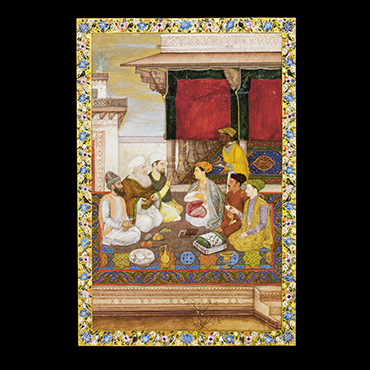A princely education
The Mughal prince in this vivid painting is identified as Murad Bakhsh, the youngest son of the emperor Shah Jahan (r. AH 1037–68/1628–58 CE), shown here in his mid-teens. Surrounded by members of the court on the right and located in a realistic Mughal palace interior, the prince converses with three revered, holy men who represent the concept of spiritual guidance that was so important to the imperial family from the reign of Akbar onwards.
Govardhan, one of the greatest artists of the imperial painting workshop from around AH 1003–55/1595–1645 CE, specialised in such scenes. His works show a strong interest in portraiture and often possess penetrating psychological acuity. Able to produce paintings of extraordinary intensity, his favorite themes were holy men and princes. That Govardhan could achieve this kind of mastery even near the end of his long career is further testimony to his status as one of the greatest of all Mughal painters.
The holy men and their royal student form a semi-circular area with a variety of luxurious objects in the foreground. Just below the seated prince is likely a manuscript wrapped in a green and then in a white cloth. Written conspicuously on that cloth is the ascription ‘work of Govardhan’ in the hand of Shah Jahan himself.
The folio was once part of an album assembled in Iran in the mid-eighteenth century, containing many important Mughal and Deccani paintings taken from the Mughal royal library by Nadir Shah after the sack of Delhi in AH 1151/1739. Like many of the folios in the album, the present example features calligraphy on the reverse, penned by the 11th century AH/17th-century CE Persian master Imad al-Hasani. The borders on each side are signed by the Persian artists Muhammad Baqir and Muhammad Hadi, the latter dated AH 1170/1756–57 CE.
Prince Murad Bakhsh with Holy Men and Attendants
Painted by Govardhan
India, c. AH 1047/1638 CE
Paper, opaque pigments, gold, ink, h. 23.9 × w. 15 cm
The Al Thani Collection, ATC721

